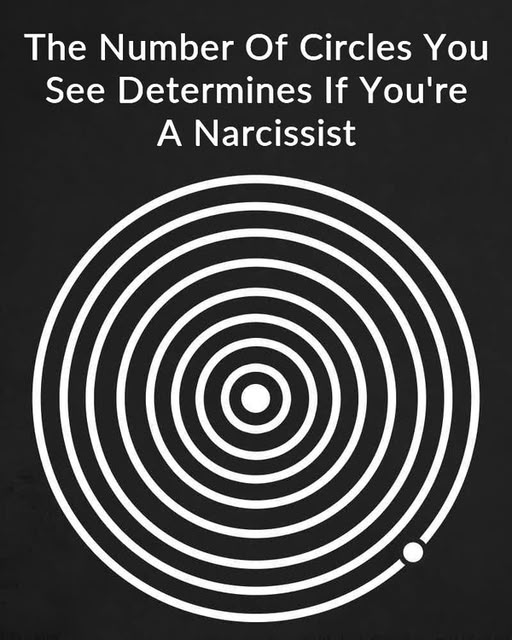
Optical illusions have always captivated us, revealing how our brains interpret the world in unexpected ways. Recently, a new viral illusion has taken social media by storm, claiming that the number of circles you see in a specific image can determine whether you have narcissistic tendencies. But how accurate is this claim, really?
Let’s dive deeper into what’s behind this trending meme, what optical illusions truly tell us about personality, and why you shouldn’t rush to self-diagnose based on a quick glance at a few circles.
The Optical Illusion That’s Stirring Up Debate
The viral image is simple yet surprisingly complex. At first glance, you see a grid-like arrangement of overlapping black and white patterns. Within that structure, numerous faint circles are hidden.
The premise shared across memes is straightforward: the more circles you can spot, the less narcissistic you are supposed to be. Conversely, spotting fewer circles allegedly points toward a higher level of narcissism.
Thousands of people have commented, shared, and even jokingly “diagnosed” themselves based on how many circles they counted. But is there any scientific basis for this interpretation?
Spoiler: not really.
How Optical Illusions Actually Work
Optical illusions like this one aren’t designed to assess personality traits like narcissism. Instead, they showcase how our brains fill in visual gaps, manage complexity, and interpret contrast, light, and structure.
In this particular illusion, your brain must distinguish subtle outlines of circles hidden within a more dominant grid pattern. The difficulty in spotting the circles depends less on your personality and more on how your visual processing system deals with contrast and detail.
Some factors that influence how many circles you see include:
-
Lighting conditions (brighter screens may reveal more)
-
Visual acuity (sharpness of your vision)
-
Level of focus (whether you’re quickly glancing or concentrating deeply)
-
Device used (phone screens versus larger monitors)
None of these factors have anything to do with narcissism.
Where the Narcissism Myth Came From
The “narcissist test” meme is an example of how a simple idea can go viral, even without scientific backing. People love quick, entertaining insights into their personalities—especially when they involve interactive content like visual puzzles.
At some point, someone jokingly linked the difficulty of spotting the circles to narcissism, probably because narcissism is a popular, often misunderstood concept in pop culture. The meme took off because it’s relatable, shareable, and easy to laugh about with friends.
However, narcissism is a serious psychological condition, not something that can be determined by a glance at an optical illusion. Clinical narcissistic personality disorder (NPD) involves a long-standing pattern of grandiosity, a constant need for admiration, and a lack of empathy—not the inability to spot a hidden circle on your screen.
Why We Love Linking Illusions to Personality
Even though there’s no clinical truth to the “circle test,” it taps into something very real: our desire for self-understanding.
Optical illusions, personality quizzes, and viral memes all appeal to our natural curiosity about ourselves and others. We like to think there are hidden layers to our perception and behavior—because there are! But interpreting illusions as diagnostic tools is taking a fun concept a little too far.
Still, illusions can provide some genuine insights:
-
Attention to detail: People who slow down and observe carefully might catch more hidden features.
-
Cognitive flexibility: Those able to shift their perspective or look beyond the obvious may perform better in visual puzzles.
-
Patience and persistence: People willing to spend more time looking are likelier to spot more hidden elements.
None of these traits, however, correlate specifically with narcissism.
A Real Look at Narcissism
If you’re truly curious about narcissism, psychologists use a variety of validated tools, like the Narcissistic Personality Inventory (NPI), to assess it—not viral illusions.
Signs of clinical narcissism include:
-
Grandiose sense of self-importance
-
Preoccupation with fantasies of unlimited success, power, or beauty
-
Believing they are “special” and unique
-
Requiring excessive admiration
-
A sense of entitlement
-
Interpersonally exploitative behavior
-
Lack of empathy
-
Envy of others or belief that others are envious of them
-
Arrogant, haughty behaviors or attitudes
Most people show a few narcissistic traits occasionally—that’s normal. It only becomes a disorder when these traits are inflexible, pervasive, and cause significant problems in work or relationships.
Final Thoughts: Enjoy the Illusion, But Keep It in Perspective
Spotting circles—or missing them—has nothing to do with whether you’re a narcissist. Optical illusions are fascinating exercises that show how complex, clever, and sometimes flawed human perception can be.
So next time you encounter a meme claiming it can “reveal your true self” in 10 seconds or less, take it with a grain of salt. Enjoy the fun, marvel at how your brain tries to make sense of the visual world, and maybe even learn something about your focus or patience—but leave the serious personality evaluations to qualified professionals.
In the end, how many circles you see says more about how your eyes and brain work together than about the kind of person you are. And that’s pretty amazing all on its own.





